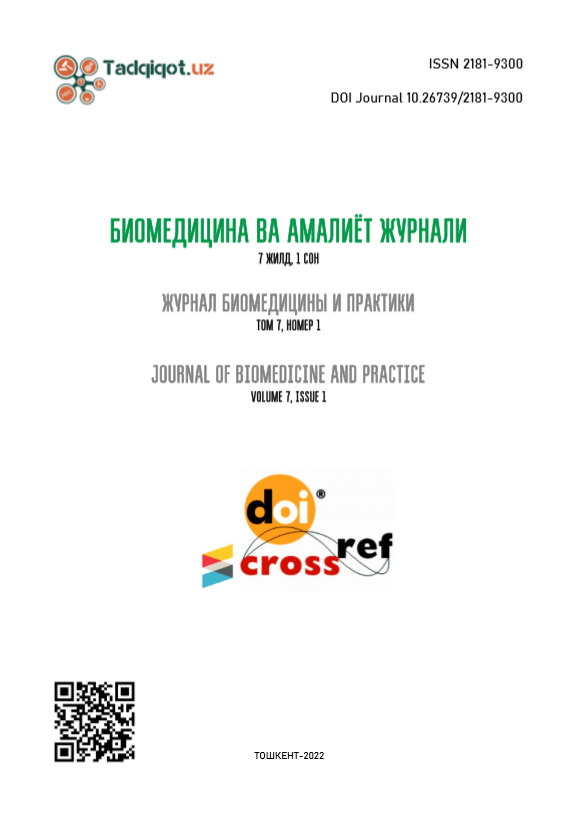LABORATORY INDICATORS IN UROLITHIASIS AND ASSESSMENT OF QUALITY CONTROL OF LABORATORY DIAGNOSTICS AT THE STAGE OF INPATENT TREATMENT
Keywords:
laboratory tests, urolithiasis, the quality of laboratory tests, biochemical research, hematological research, general urine analysisAbstract
Objective: Evaluation of clinical and laboratory parameters in patients with urolithiasis and analysis of the quality of laboratory care at the stationary stage.
Methods: The appealability was studied at the 2nd clinic of SamMI with urolithiasis, for 2019-2020 in the Samarkand region. All patients underwent a general clinical examination, including a general urine analysis, biochemical, hematological and coagulogram analysis.
Results: With a complete clinical and laboratory examination, it turned out that the erythrocyte sedimentation rate (ESR) in all patients is increased in the OAC, while the number of leukocytes increases, the number of erythrocytes is reduced, hemoglobin in the peripheral blood, the color index is below normal and LII is increased. In the study of the biochemical parameters of the serum of patients, it was found that creatinine and urea were sharply increased. Transaminase enzymes are elevated with a predominance of AST. Indicators of electrolyte balance: sodium exceeds the norm, potassium and chlorine are within the normal range, total protein and calcium are lowered (hypocalcemia is not associated with LAB). The analysis showed that the volume of laboratory tests, guaranteed by the standards of medical care, patients with ICD were provided in most cases (95.0%) in full in accordance with the requirements of the EMS.
Conclusions. Thus, an increase in LII, leukocytosis, erythrocytopenia was observed in all patients without exception. In groups 1 and 2, it was found that transaminase enzymes in the blood increase the level of urea, creatinine and decrease the total protein. Revealed the presence in the urine of total protein, erythrocytes, leukocytes. The range of changes in all groups varied depending on the course of the disease.
References
Душанова Г.А., Набиева Ф.С., Садинова М.Ж., Нурматова Д.М. Анализ взаимосвязей параметров иммунного гомеостаза с сосотоянием системы ПОЛ-АОС// Вестник науки и образования № (105) часть 2. 2021, С.63-69
Г.Б. Кувандиков, З.Э.Кудратова, Н.А. Юсупова, Бердиярова Ш.Ш. Проблемы достоверность результатов лабораторной диагностики инфекций, передаваемых половым путем// EVROPEAN RESEARCH: INNOVATION IN SCIENC, EDUCATION AND TECHNOLOGY. 2020, C. 79-82.
Винниченко Л.В., Исмаилова И.А., Делягин В.М. Педиатрические аспекты мочекаменной болезни. Практическая медицина. Том 16, № 8-2018, С. 27-33
Журунова М.С., Даутова М.Б. Мочекаменная болезнь // Международный журнал прикладных и фундаментальных исследований. № 6-5. -2016, С. 977-977;
Спиридонова Е.С. Медико-социальная характеристика больных с урологической патологией // Сестринское дело и высшее сестринское образование: материалы-практической конференции. Вып 3 - 2010, С. 60-62.
Узденов М.А., Яненко Э.К., Гербекова И.Д. Консервативная противорецидивная терапия больных мочекаменной болезнью // Медицинский вестник Башкортостана. Т. 6. № 3- 2011, С. 95-99.
Филиппович В.А. Мочекаменная болезнь: пособие для студентов лечебного, медикопсихологического и медико-диагностического факультетовей // Гродно: ГрГМУ.-2015, C.1-10
Шарафутдинов М.А. Динамика и прогноз заболеваемости взрослого населения Республики Башкортостан болезнями мочеполовой системы // Медицинский вестник Башкортостана. № 6- 2010, С. 11
Bae S.R., Seong J.M., Kim L.Y., Paick S.H. et al. The epidemiology of reno-ureteral stone disease in Koreans: a nationwide population-based study // Urolithiasis. 2014. V. 42 (2). P. 109-6. Chand R.B. Common site of urinary calculi in kidney, ureter and bladder region // Nepal Med Coll J. V. 15 (1)- 2013, P. 5-7.
Damasio P.C., Amaro C.R., Padovani C.R., Leitao V.A. et al. Influence of clinical therapy and nutritional counseling on the recurrence of urolithiasis // Acta Cir Bras. V. 29(6)- 2014, P. 400-404.
Jichlinski P.Urology // Rev Med Suisse. V. 10 - 2014, P. 127
Lotan Y. Cost-effectiveness of primary prevention strategies for nephrolithiasis // J Urol. V. 186(2)- 2011, P. 550-555.
Rizaev J.A., Khazratov A.I. Carcinogenic effect of 1,2 - dimethylhydrazine on organism as a whole // Problems of biology and medicine, № 1-2020, Vol. 116. С. 269.
Rizaev J.A., Khazratov A.I., Lisnichuk N.E., Olimjonov K.J., Reimnazarova G.J. Pathomorphological changes in the oral mucosa in patients with colon cancer// European Journal of Molecular & Clinical Medicine, vol.7- 2021, Issue 7, P.666-672.

